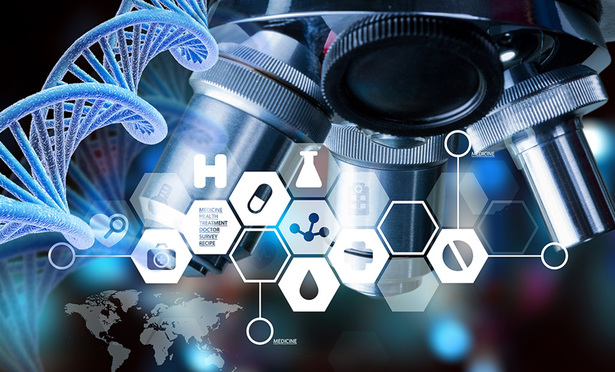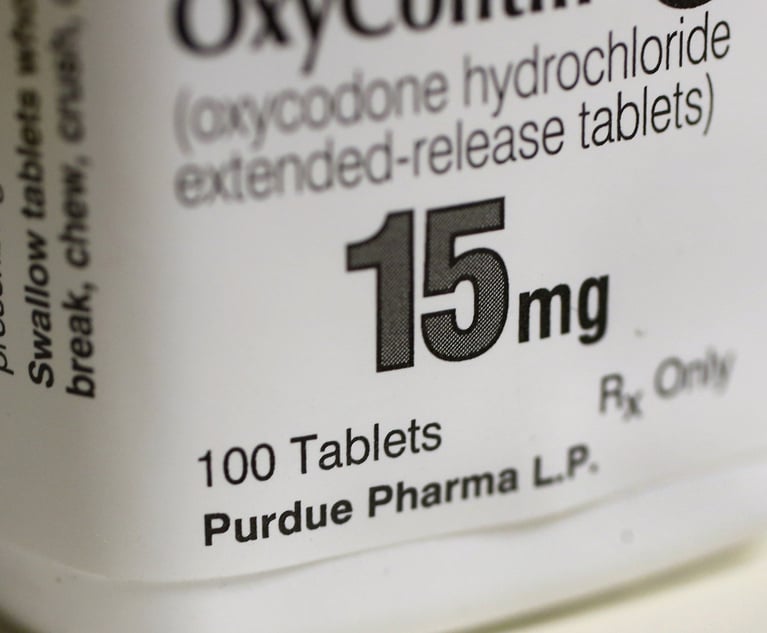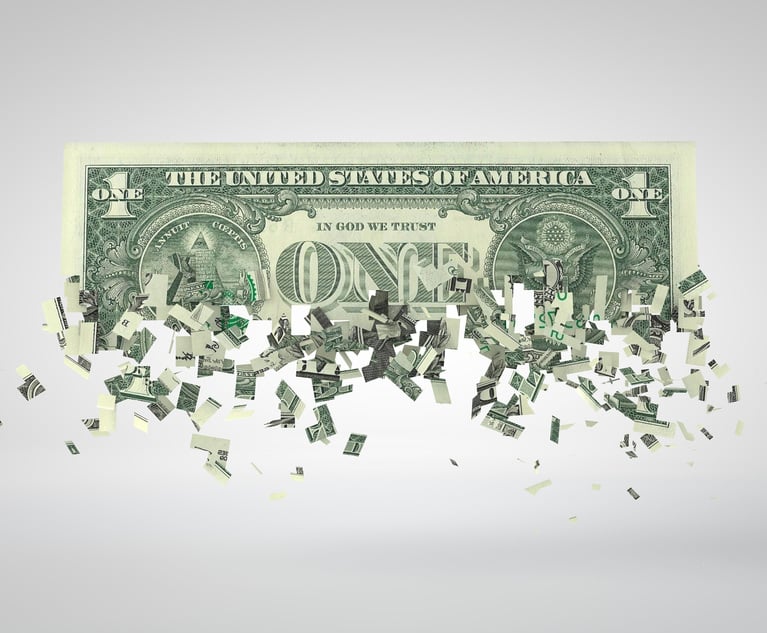The Uphill Battle: Challenging Bio-Pharma in IPRs
Since the Hatch-Waxman Act has been in effect, there has been an increase in the number of challenges to patents covering chemical compounds. With the advent of inter partes reviews, the expectation was that there would be an uptick in compound claims being found obvious due to the expertise of the Patent Trial and Appeal Board. That has not been the case. Instead, as outlined here, the exact opposite has happened.
March 22, 2019 at 03:10 PM
8 minute read
 Since the Hatch-Waxman Act has been in effect, there has been an increase in the number of challenges to patents covering chemical compounds. Many of these compounds are merely minor changes to existing known chemical structures or compounds that were discovered by teams using brute force. There is very little, if any, “inventiveness” to these structures. However, in our review of cases there appears only to have been one case that found claims directed to compounds to be obvious. With the advent of inter partes reviews (IPR), the expectation was that there would be an uptick in compound claims being found obvious due to the expertise of the Patent Trial and Appeal Board (PTAB). That has not been the case. Instead, as outlined below, the exact opposite has happened. The courts' and PTAB's application of KSR remains too rigid and fails the basic tenets of that decision with too much deference to Big Pharma. This needs to change.
Since the Hatch-Waxman Act has been in effect, there has been an increase in the number of challenges to patents covering chemical compounds. Many of these compounds are merely minor changes to existing known chemical structures or compounds that were discovered by teams using brute force. There is very little, if any, “inventiveness” to these structures. However, in our review of cases there appears only to have been one case that found claims directed to compounds to be obvious. With the advent of inter partes reviews (IPR), the expectation was that there would be an uptick in compound claims being found obvious due to the expertise of the Patent Trial and Appeal Board (PTAB). That has not been the case. Instead, as outlined below, the exact opposite has happened. The courts' and PTAB's application of KSR remains too rigid and fails the basic tenets of that decision with too much deference to Big Pharma. This needs to change.
The American Invents Act (AIA) of 2011 created IPR proceedings allowing patentability challenges to already established patents. With over eight thousand IPR petitions filed between 2012 and 2018 per the June 2018 U.S. Patent and Trademark Office (USPTO) Trial Statistics IPR, PGR, CBM, PTAB report, the IPR procedure quickly garnered the name “patent death squad.” possibly undeservingly so, since the PTAB denied 63 percent of the 955 IPR challenges issued in 2017. Id. Eighty-three percent of IPR challenges involve electrical, computer, and mechanical and only 10 percent of the challenges related to bio-pharma. Interestingly, bio-pharma IPR challenges dropped from 16 percent to 10 percent when comparing 2018 and 2017 USPTO Trial Statistics reports.
In 2015 Biotechnology Innovation Organization and the Pharmaceutical Research Manufacturers of America launched an extensive lobbying campaign seeking a blank exemption from IPR challenges which was ultimately denied. Despite this, bio-pharma patents appear resilient in IPR proceedings. In comparison to other technology challenges in 2017, the PTAB granted institution of 53 percent of IPR challenges while bio-pharma lingers at 44 percent.
Pharmaceutical patents only need to cover the compound, method, or treatment to seek eligibility for listing in the Orange Book which precludes generic manufactures from obtaining market approval under the Hatch-Waxman Act. Any challenge under IPR must demonstrate that the precise method utilized by the inventor was obvious under §103 or anticipated under §102(b) thus unpatentable. In order to survive the first stage of an IPR challenge, the petitioner must establish that at least one claim has “a reasonable likelihood of prevailing in demonstrating the obviousness [or anticipation] of claim” under 35 U.S.C. §314(a).
Obviousness has long been defined by the courts through the four “Graham factors” set out by Graham v. John Deere Co., 383 U.S. 1 (1966) and the common law doctrine commonly known as “Teaching-Suggestion-Motivation Test” (the TSM Test). In KSR International Co. v. Teleflex, 550 U.S. 398, 127 S. Ct. 1727, 1730, 167 L. Ed. 2d 705 (2007) the Supreme Court specifically disagreed with the underlying court's “narrow, rigid manner … inconsistent with [§103]” and invalidated the patent as KSR presented “convincing evidence … [the concept was] … well within the grasp of a person of ordinary skill in the relevant art and that the benefit of doing so would be obvious.” Id. at 400. Notably, the court held that the underlying courts' interpretation of the TSM Test was too rigid, finding the TSM Test to be a “helpful insight,” not a controlling one. Several academics argued whether the elimination of the TSM Test meant increased difficulty to secure patents, as in “How KSR v. Teleflex's Nonobviousness Test Conflicts with the Scientific Method and Removes the Incentive to Innovate,” 35 U. Dayton L. Rev. 413, 415 (2010). Empirical research in Brendan Seth O'Brien O'Shea, “What Is Obvious: Empirical Assessment of KSR's Impact,” 45 AIPLA Q.J. 517, 519 (2017) suggests that rejections for obviousness only increased by 10 percent since KSR. The study advises that the KSR ruling appears to make it more difficult for USPTO obviousness finding to be reversed.
Although pharmaceutical patents, unlike other technology patents, are usually drafted with a high level of specificity, making IPR challenges difficult, the PTAB has set an unreasonable standard for review for obviousness. A review of the PTAB's denials of inter partes review indicates that pharmaceutical IPR petitioners must present extensive foundation to survive and appears to be a much higher standard than “reasonable likelihood” or “convincing evidence” indicated by the court in KSR—a high standard that the court in KSR specifically denounced.
Overall, the PTAB's largest number of invalidations derive from petitioners failing to elucidate an adequately viable explanation of how the subject matter of the patent was obvious at the time of filing as evidenced in Initiative for Medicines, Access & Knowledge (I-Mak) v. Gilead Pharmasset, No. IPR2018-00390, 2018 WL 3493156 (P.T.A.B. July 19, 2018), but the invalidations also reveal that the PTAB requires petitioners to submit unmitigated evidence to challenge the “obviousness” of a drug. This is clearly not the standard set forth by the court in KSR. The PTAB remains quick to challenge a petitioner's sources that did not come from textbook or journal articles, off-handedly dismissing FDA labels or drug websites. In Pfizer v. Biogen, No. IPR2017-01166, 2017 WL 5484417 (P.T.A.B. Nov. 13, 2017) the PTAB denied institution because the challenger could not definitively prove that an FDA label or the drug's website were “publicly accessible” by the “critical date.” Notably, the PTAB dismissed the challenger's evidence of two scientific papers published around the “critical date” but not widely accessible before the “critical date.” Failure to authenticate commonly leads the PTAB to deny inter partes review. In comparison, the PTAB granted inter partes review for a method of removing contaminated DNA as the challenger presented extensive evidence that the method was consistent with the teaching in the prior art in Pfizer v. Chugai Pharm. Co. Ltd., No. IPR2017-01357, 2017 WL 6040045 (P.T.A.B. Dec. 1, 2017).
The PTAB routinely chastises petitioners for constructing a defense mainly out of hindsight similar to Sandoz v. AbbVie Biotechnology, No. IPR2018-00156, 2018 WL 2735468 (P.T.A.B. June 5, 2018). In 10x Genomics v. Bio-Rad Labs., No. IPR2018-00434, 2018 WL 3216962 (P.T.A.B. June 29, 2018) the PTAB denied institution as the petitioner “impermissibly relies on hindsight” arguing the invention was obvious to a person of ordinary skill in the art. Id. at 5. The PTAB further noted that the petitioner failed to demonstrate the person of ordinary skill had a “reasonable expectation of success.” Id. In contrast, in Anacor Pharm. v. Iancu, 889 F.3d 1372, 1375 (Fed. Cir. 2018), the court invalidated a patent based on prior art references disclosing use of oxaboroles and tavaboroles being effective anti-fungal treatment and concluded that a person of ordinary skill would have thought it reasonable to apply tavaboroles to treat other fungi infections.
In Complex Innovations v. Ab, No. IPR2017-00631, 2017 WL 3142064 (P.T.A.B. July 24, 2017), the PTAB acknowledged that a person of skill likely knew of and was “motivated” by prior art but denied inter partes review as the petitioner failed to demonstrate sufficient evidence or logic as to how the prior art actually led to the formulation of the specific compounds challenged. The PTAB specifically noted that the prior art never mentioned a compound comprising active ingredients of budesonide, formoterol, PVP, and PEG. This clearly sets forth a standard for obviousness too high for any bio-pharma case to meet. We acknowledge the inherent difficultly and unpredictable nature of experimenting in the field of chemistry but requiring prior to specifically list every compound feasible goes too far. In Bristol-Myers Squibb Co. v. Teva Pharm. USA, Inc., 752 F.3d 967, 970 (Fed. Cir. 2014), the court upheld the invalidation of a patent for obviousness because a drug's “unexpected properties” was not sufficient to establish patentability.
In light of the PTAB's narrow interpretation of obviousness, petitioners, initially denied inter partes review, commonly reevaluate their evidence and/or strategies and file secondary petitions similar to Pfizer v. Biogen, No. IPR2018-00086, 2018 WL 2553245 (P.T.A.B. May 31, 2018). The PTAB recently declined inter partes review in part due to the petitioner's admission in Aurobindo Pharma Usa v. Corp., No. IPR2018-00530, 2018 WL 4223841, at *4 (P.T.A.B. Sept. 5, 2018) noting
[that the petitioner] used [PTAB's] decision in the First IPR as a roadmap to shift its strategy and reformulate its challenge to the claims of the '459 patent. As stated in General Plastic, “this is unfair to patent owners and is an inefficient use of the inter partes review process.” Id. at 4 (internal citations omitted).
With this argument being increasingly utilized, petitioners should be aware that their first IPR challenge may be their only IPR challenge. Care should be taken in ensuring authentication, proper development of prior art references, and consistent logic, not conclusory statements, before issuing the IPR challenge. Of course, even if the PTAB grants inter partes review, our research indicates that approximately 50 percent of patents survived with no claims being invalidated. It is vital when pursuing invalidity of drug patents to understand that this is an uphill battle and parties should argue that the standard elucidated by KSR should control. Aggressively arguing against the rigid TSM standard and applying KSR to the PTAB should be at the forefront of any structural obviousness argument.
Debra Doby and Michael Siem are partners at Goldberg Segalla.
This content has been archived. It is available through our partners, LexisNexis® and Bloomberg Law.
To view this content, please continue to their sites.
Not a Lexis Subscriber?
Subscribe Now
Not a Bloomberg Law Subscriber?
Subscribe Now
NOT FOR REPRINT
© 2025 ALM Global, LLC, All Rights Reserved. Request academic re-use from www.copyright.com. All other uses, submit a request to [email protected]. For more information visit Asset & Logo Licensing.
You Might Like
View All

NY Ready to Reopen Claim Against Purdue Pharma, If 60-Day Negotiating Window Closes Without Accord


Ready to Meet the Moment: Data Privacy and Cybersecurity Concerns Echo Throughout Biotech and Synthetic Biology
10 minute readTrending Stories
- 1States Accuse Trump of Thwarting Court's Funding Restoration Order
- 2Microsoft Becomes Latest Tech Company to Face Claims of Stealing Marketing Commissions From Influencers
- 3Coral Gables Attorney Busted for Stalking Lawyer
- 4Trump's DOJ Delays Releasing Jan. 6 FBI Agents List Under Consent Order
- 5Securities Report Says That 2024 Settlements Passed a Total of $5.2B
Who Got The Work
J. Brugh Lower of Gibbons has entered an appearance for industrial equipment supplier Devco Corporation in a pending trademark infringement lawsuit. The suit, accusing the defendant of selling knock-off Graco products, was filed Dec. 18 in New Jersey District Court by Rivkin Radler on behalf of Graco Inc. and Graco Minnesota. The case, assigned to U.S. District Judge Zahid N. Quraishi, is 3:24-cv-11294, Graco Inc. et al v. Devco Corporation.
Who Got The Work
Rebecca Maller-Stein and Kent A. Yalowitz of Arnold & Porter Kaye Scholer have entered their appearances for Hanaco Venture Capital and its executives, Lior Prosor and David Frankel, in a pending securities lawsuit. The action, filed on Dec. 24 in New York Southern District Court by Zell, Aron & Co. on behalf of Goldeneye Advisors, accuses the defendants of negligently and fraudulently managing the plaintiff's $1 million investment. The case, assigned to U.S. District Judge Vernon S. Broderick, is 1:24-cv-09918, Goldeneye Advisors, LLC v. Hanaco Venture Capital, Ltd. et al.
Who Got The Work
Attorneys from A&O Shearman has stepped in as defense counsel for Toronto-Dominion Bank and other defendants in a pending securities class action. The suit, filed Dec. 11 in New York Southern District Court by Bleichmar Fonti & Auld, accuses the defendants of concealing the bank's 'pervasive' deficiencies in regards to its compliance with the Bank Secrecy Act and the quality of its anti-money laundering controls. The case, assigned to U.S. District Judge Arun Subramanian, is 1:24-cv-09445, Gonzalez v. The Toronto-Dominion Bank et al.
Who Got The Work
Crown Castle International, a Pennsylvania company providing shared communications infrastructure, has turned to Luke D. Wolf of Gordon Rees Scully Mansukhani to fend off a pending breach-of-contract lawsuit. The court action, filed Nov. 25 in Michigan Eastern District Court by Hooper Hathaway PC on behalf of The Town Residences LLC, accuses Crown Castle of failing to transfer approximately $30,000 in utility payments from T-Mobile in breach of a roof-top lease and assignment agreement. The case, assigned to U.S. District Judge Susan K. Declercq, is 2:24-cv-13131, The Town Residences LLC v. T-Mobile US, Inc. et al.
Who Got The Work
Wilfred P. Coronato and Daniel M. Schwartz of McCarter & English have stepped in as defense counsel to Electrolux Home Products Inc. in a pending product liability lawsuit. The court action, filed Nov. 26 in New York Eastern District Court by Poulos Lopiccolo PC and Nagel Rice LLP on behalf of David Stern, alleges that the defendant's refrigerators’ drawers and shelving repeatedly break and fall apart within months after purchase. The case, assigned to U.S. District Judge Joan M. Azrack, is 2:24-cv-08204, Stern v. Electrolux Home Products, Inc.
Featured Firms
Law Offices of Gary Martin Hays & Associates, P.C.
(470) 294-1674
Law Offices of Mark E. Salomone
(857) 444-6468
Smith & Hassler
(713) 739-1250






